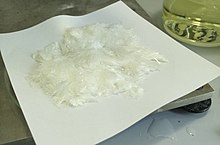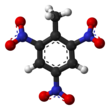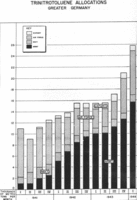TNT
| |||

| |||
| Names | |||
|---|---|---|---|
| Preferred IUPAC name
2-Methyl-1,3,5-trinitrobenzene[citation needed] | |||
Other names
| |||
| Identifiers | |||
3D model (
JSmol ) |
|||
| Abbreviations | TNT | ||
| ChEMBL | |||
| ChemSpider | |||
| DrugBank | |||
ECHA InfoCard
|
100.003.900 | ||
| EC Number |
| ||
| KEGG | |||
PubChem CID
|
|||
RTECS number
|
| ||
| UNII | |||
| UN number | 0388, 0389 – Mixtures with trinitrobenzene, hexanitrostilbene
| ||
CompTox Dashboard (EPA)
|
|||
| |||
| |||
| Properties | |||
| C7H5N3O6 | |||
| Molar mass | 227.132 g·mol−1 | ||
| Appearance | Pale yellow solid. Loose "needles", flakes or prills before melt-casting. A solid block after being poured into a casing. | ||
| Density | 1.654 g/cm3 | ||
| Melting point | 80.35 °C (176.63 °F; 353.50 K) | ||
| Boiling point | 240.0 °C (464.0 °F; 513.1 K) (decomposes)[1] | ||
| 0.13 g/L (20 °C) | |||
| Solubility in ether, acetone, benzene, pyridine | soluble | ||
| Vapor pressure | 0.0002 mmHg (20°C)[2] | ||
| Explosive data | |||
| Shock sensitivity | Insensitive | ||
| Friction sensitivity | Insensitive to 353 N | ||
| Detonation velocity | 6900 m/s | ||
RE factor
|
1.00 | ||
| Hazards | |||
| GHS labelling: | |||
   
| |||
| Danger | |||
| H201, H301, H311, H331, H373, H411 | |||
| P210, P273, P309+P311, P370+P380, P373, P501 | |||
| NFPA 704 (fire diamond) | |||
| Lethal dose or concentration (LD, LC): | |||
LD50 (median dose)
|
795 mg/kg (rat, oral) 660 mg/kg (mouse, oral)[3] | ||
LDLo (lowest published)
|
500 mg/kg (rabbit, oral) 1850 mg/kg (cat, oral)[3] | ||
| NIOSH (US health exposure limits): | |||
PEL (Permissible)
|
TWA 1.5 mg/m3 [skin][2] | ||
REL (Recommended)
|
TWA 0.5 mg/m3 [skin][2] | ||
IDLH (Immediate danger) |
500 mg/m3[2] | ||
| Safety data sheet (SDS) | ICSC 0967 | ||
| Related compounds | |||
Related compounds
|
picric acid hexanitrobenzene 2,4-Dinitrotoluene | ||
Except where otherwise noted, data are given for materials in their standard state (at 25 °C [77 °F], 100 kPa).
| |||
Trinitrotoluene (
History
TNT was first prepared in 1863 by German chemist Julius Wilbrand[6] and originally used as a yellow dye. Its potential as an explosive was not recognized for three decades, mainly because it was too difficult to detonate because it was less sensitive than alternatives. Its explosive properties were discovered in 1891 by another German chemist, Carl Häussermann.[7] TNT can be safely poured when liquid into shell cases, and is so insensitive that in 1910 it was exempted from the UK's Explosives Act 1875 and was not considered an explosive for the purposes of manufacture and storage.[8]
The German armed forces adopted it as a filling for artillery shells in 1902. TNT-filled armour-piercing shells would explode after they had penetrated the armour of British capital ships, whereas the British Lyddite-filled shells tended to explode upon striking armour, thus expending much of their energy outside the ship.[8] The British started replacing Lyddite with TNT in 1907.[9]
The
-
Chunks of explosives-grade TNT
-
Trinitrotoluene melting at 81 °C (178 °F)
-
M795 artillery shells with fuzesfitted, labelled to indicate a filling of TNT
-
A group of M120 Rak mortar shells. The dark green shells on the left are stencilled to indicate a filling of TNT
-
Analysis of TNT production by branch of the German armed forces between 1941 and the first quarter of 1944, shown in thousands of tons per month
-
Detonation of the 500-ton TNT explosive charge as part of Operation Sailor Hat in 1965. The passing blast-wave left a white water surface behind and a white condensation cloud is visible overhead.
Preparation
In industry, TNT is produced in a three-step process. First,
Control of
In the laboratory, 2,4,6-trinitrotoluene is produced by a two-step process. A nitrating mixture of concentrated nitric and sulfuric acids is used to nitrate toluene to a mixture of mono- and di-nitrotoluene isomers, with careful cooling to maintain temperature. The nitrated toluenes are then separated, washed with dilute
Applications
TNT is one of the most commonly used explosives for military, industrial, and mining applications. TNT has been used in conjunction with
TNT is valued partly because of its insensitivity to shock and friction, with reduced risk of accidental detonation compared to more sensitive explosives such as nitroglycerin. TNT melts at 80 °C (176 °F), far below the temperature at which it will spontaneously detonate, allowing it to be poured or safely combined with other explosives. TNT neither absorbs nor dissolves in water, which allows it to be used effectively in wet environments. To detonate, TNT must be triggered by a pressure wave from a starter explosive, called an explosive booster.[13]
Although blocks of TNT are available in various sizes (e.g. 250 g, 500 g, 1,000 g), it is more commonly encountered in
- Amatex (ammonium nitrate and RDX)[14]
- Amatol (ammonium nitrate[15])
- Baratol (barium nitrate and wax[citation needed])
- Composition B (RDX and paraffin wax[16])
- Composition H6
- Cyclotol (RDX)[17]
- Ednatol
- Hexanite[citation needed] (hexanitrodiphenylamine[18][19])
- Minol
- Octol
- Pentolite
- Picratol
- Tetrytol
- Torpex
- Tritonal
Explosive character
Upon detonation, TNT undergoes a decomposition equivalent to the reaction
- 2 C7H5N3O6 → 3 N2 + 5 H2 + 12 CO + 2 C
plus some of the reactions
- H
2 + CO → H
2O + C
and
- 2 CO → CO
2 + C.
The reaction is
TNT can be detonated with a high velocity initiator or by efficient concussion.[21] For many years, TNT used to be the reference point for the Figure of Insensitivity. TNT had a rating of exactly 100 on the "F of I" scale. The reference has since been changed to a more sensitive explosive called RDX, which has an F of I rating of 80.[22]
Energy content

The energy density of TNT is used as a reference point for many other explosives, including nuclear weapons, as their energy content is measured in equivalent tonnes (metric tons, t) of TNT. The energy used by
For safety assessments, it has been stated that the detonation of TNT, depending on circumstances, can release 2.673–6.702 GJ/t.[24]
The heat of combustion however is 14.5 GJ/t (14.5 MJ/kg or 4.027 kWh/kg), which requires that the carbon in TNT fully react with atmospheric oxygen, which does not occur in the initial event.[25]
For comparison, gunpowder contains 3 MJ/kg, dynamite contains 7.5 MJ/kg, and gasoline contains 47.2 MJ/kg (though gasoline requires an oxidant, so an optimized gasoline and O2 mixture contains 10.4 MJ/kg).[citation needed]
Detection
Various methods can be used to detect TNT, including optical and
Safety and toxicity
TNT is poisonous, and skin contact can cause skin irritation, causing the skin to turn a bright yellow-orange color. During the
People exposed to TNT over a prolonged period tend to experience anemia and abnormal liver functions. Blood and liver effects, spleen enlargement and other harmful effects on the immune system have also been found in animals that ingested or breathed trinitrotoluene. There is evidence that TNT adversely affects male fertility.[28] TNT is listed as a possible human carcinogen, with carcinogenic effects demonstrated in animal experiments with rats, although effects upon humans so far amount to none (according to IRIS of March 15, 2000).[29] Consumption of TNT produces red urine through the presence of breakdown products and not blood as sometimes believed.[30]
Some military testing grounds are contaminated with wastewater from munitions programs, including contamination of surface and subsurface waters which may be colored pink because of the presence of TNT. Such contamination, called "pink water", may be difficult and expensive to remedy.[citation needed]
TNT is prone to
Pink and red water
Pink water and red water are two distinct types of
Pink and red water are colorless at the time of generation; the color is produced by
Because of the toxicity of TNT, the discharge of pink water to the environment has been prohibited in the US and many other countries for decades, but ground contamination may exist in very old plants. However, RDX and tetryl contamination is usually considered more problematic, as TNT has very low soil mobility. Red water is significantly more toxic and as such it has always been considered hazardous waste. It has traditionally been disposed of by evaporation to dryness (as the toxic components are not volatile), followed by incineration. Much research has been conducted to develop better disposal processes.[citation needed]
Ecological impact
Because of its suitability in construction and demolition, TNT has become the most widely used explosive and thus its toxicity is the most characterized and reported. Residual TNT from manufacture, storage, and use can pollute water, soil, the atmosphere, and the biosphere.[37]
The concentration of TNT in contaminated soil can reach 50 g/kg of soil, where the highest concentrations can be found on or near the surface. In September 2001, the United States Environmental Protection Agency (USEPA) declared TNT a pollutant whose removal is a priority.[38] The USEPA maintains that TNT levels in soil should not exceed 17.2 milligrams per kilogram of soil and 0.01 milligrams per litre of water.[39]
Aqueous solubility
Soil adsorption
Adsorption is a measure of the distribution between soluble and sediment adsorbed contaminants following attainment of equilibrium. TNT and its transformation products are known to adsorb to surface soils and sediments, where they undergo reactive transformation or remained stored.[43] The movement or organic contaminants through soils is a function of their ability to associate with the mobile phase (water) and a stationary phase (soil). Materials that associate strongly with soils move slowly through soil.
The association constant for TNT with soil is 2.7 to 11 L/kg of soil.
The number of functional groups on TNT influences the ability to adsorb into soil. Adsorption coefficient values have been shown to increase with an increase in the number of amino groups. Thus, adsorption of the TNT decomposition product 2,4-diamino-6-nitrotoluene (2,4-DANT) was greater than that for 4-amino-2,6-dinitrotoluene (4-ADNT), which was greater than that for TNT.[40] Lower adsorption coefficients for 2,6-DNT compared to 2,4-DNT can be attributed to the steric hindrance of the NO2 group in the ortho position.
Research has shown that in freshwater environments, with high abundances of Ca2+, the adsorption of TNT and its transformation products to soils and sediments may be lower than observed in a saline environment, dominated by K+ and Na+. Therefore, when considering the adsorption of TNT, the type of soil or sediment and the ionic composition and strength of the ground water are important factors.[45]
The association constants for TNT and its degradation products with clays have been determined. Clay minerals have a significant effect on the adsorption of energetic compounds. Soil properties, such as organic carbon content and cation exchange capacity have significant impacts on the adsorption coefficients.
Additional studies have shown that the mobility of TNT degradation products is likely to be lower "than TNT in subsurface environments where specific adsorption to clay minerals dominates the sorption process."
Compared to other explosives, TNT has a higher association constant with soil, meaning it adheres more with soil than with water. Conversely, other explosives, such as RDX and HMX with low association constants (ranging from 0.06 to 7.3 L/kg and 0 to 1.6 L/kg respectively) can move more rapidly in water.[40]
Chemical breakdown
TNT is a reactive molecule and is particularly prone to react with reduced components of sediments or photodegradation in the presence of sunlight. TNT is thermodynamically and kinetically capable of reacting with a wide number of components of many environmental systems. This includes wholly abiotic reactants, like hydrogen sulfide, Fe2+, or microbial communities, both oxic and anoxic and photochemical degradation.[citation needed]
Soils with high clay contents or small particle sizes and high
The transformation of TNT is significantly enhanced under anaerobic conditions as well as under highly reducing conditions. TNT transformations in soils can occur both biologically and abiotically.[45]
Evidence of the photolysis of TNT has been seen due to the color change to pink of TNT-containing wastewaters when exposed to sunlight. Photolysis is more rapid in river water than in distilled water. Ultimately, photolysis affects the fate of TNT primarily in the aquatic environment but could also affect the fate of TNT in soil when the soil surface is exposed to sunlight.[45]
Biodegradation
The ligninolytic physiological phase and manganese peroxidase system of fungi can cause a very limited amount of mineralization of TNT in a liquid culture, though not in soil. An organism capable of the remediation of large amounts of TNT in soil has yet to be discovered.[46] Both wild and transgenic plants can phytoremediate explosives from soil and water.[47]
See also
- Dynamite
- Environmental fate of TNT
- IMX-101
- List of explosives used during World War II
- Phlegmatized
- RE factor
- Table of explosive detonation velocities
- TNT equivalent
- Webster's test
References
- ^ 2,4,6-Trinitrotoluene. inchem.org[dead link]
- ^ a b c d NIOSH Pocket Guide to Chemical Hazards. "#0641". National Institute for Occupational Safety and Health (NIOSH).
- ^ a b "2,4,6-Trinitrotoluene". Immediately Dangerous to Life or Health Concentrations (IDLH). National Institute for Occupational Safety and Health (NIOSH).
- ^ "Trinitrotoluene". Merriam-Webster.com Dictionary.
- ^ "Trinitrotoluene,". Dictionary.com Unabridged (Online). n.d.
- .
- ISBN 978-3-540-30421-0.
- ^ ISBN 978-0-7509-1878-7.
- ^ Norman Skentelbery (1975). Arrows to Atom Bombs: A History of the Ordnance Board (2nd ed.). Ordnance Board. p. 99.
- ^ Fairfield AP (1921). Naval Ordnance. Lord Baltimore Press. pp. 49–52.
- ISBN 978-0-08-010238-2.
- Bibcode:1976sots.rept...98M. Archived from the original(PDF) on 2 October 2018. Retrieved 27 March 2015.
- ^ "TNT". www.ch.ic.ac.uk. Retrieved 2022-02-28.
- ISBN 978-0-85177-329-2.
- ^ U.S. Explosive Ordnance, Bureau of Ordnance. Washington, D.C.: U.S. Department of the Navy. 1947. p. 580.
- ^ Military Specification MIL-C-401
- ISBN 978-0-471-18636-6.
- ^ [secondary source] webpages:submarine torpedo explosive Archived 2013-01-02 at archive.today Retrieved 2011-12-02
- ^ scribd.com website showing copy of a North American Intelligence document see:page 167 Archived 2013-05-10 at the Wayback Machine Retrieved 2011-12-02
- PMID 24495109.
- ^ Merck Index, 13th Edition, 9801
- ^ "Figure of Insensitivity | 1 Publications | 12 Citations | Top Authors | Related Topics". SciSpace - Topic. Retrieved 2023-07-21.
- ^ "Guide for the Use of the International System of Units (SI)". 2008. Retrieved 2024-03-25.
- ^ "Blast effects of external explosions (Section 4.8 Limitations of the TNT equivalent method)". 2011. p. 16. Archived from the original on 2016-08-10.
- ISBN 978-0-9728111-3-2.
- ^ Grad P (April 2013). "Quantum clusters serve as ultra-sensitive detectors". Chemical Engineering.
- ^ "The Canary Girls: The workers the war turned yellow". BBC News. 2017-05-20. Retrieved 2021-02-07.
- ^ Toxicological Profile for 2,4,6-Trinitrotoluene. atsdr.cdc.gov
- ^ "2,4,6-Trinitrotoluene". www.nlm.nih.gov.
- ^ "2,4,6-Trinitrotoluene" (PDF). Agency for Toxic Substances and Disease Registry. Retrieved 2010-05-17.
- ISBN 978-0-85404-640-9.
- ^ "Explosive & Propellant Additives". islandgroup.com. Archived from the original on 2016-03-04. Retrieved 2014-06-07.
- ISBN 0-8493-5128-6.
- ^ National Defense Center for Environmental Excellence. Pink Water Treatment Options (PDF) (Report). U.S. Army Environmental Center. Retrieved 2024-04-25.
- ^ a b Van Deuren J, Lloyd T, Chhetry S, Liou R, Peck J (January 2002). Remediation Technologies Screening Matrix and Reference Guide (Report) (4 ed.). U.S. Army Environmental Center. Retrieved 2024-04-25.
- ^ Burlinson NE, Kaplan LA, Adams CE (1973-10-03). Photochemistry of TNT: Investigation of the "Pink Water" Problem (PDF) (Report). U.S. Army Environmental Center. Retrieved 2024-04-25.
- ^ Ascend Waste and Environment (7 June 2015). The health and environmental impacts of hazardous wastes: Impact Profiles (PDF). awe.gov.au (Report). Retrieved 22 April 2022.
- ^ PMID 11527999.
- PMID 20347218.
- ^ .
- PMID 15757688.
- PMID 12187997.
- PMID 19329139.
- .
- ^ .
- S2CID 22362850.
- PMID 22996005.
External links
- Dynamite and TNT at The Periodic Table of Videos(University of Nottingham)
- "TNT" on YouTube showing the shockwave and typical black smoke cloud from detonation of 160 kilograms of pure TNT
- CDC – NIOSH Pocket Guide to Chemical Hazards










